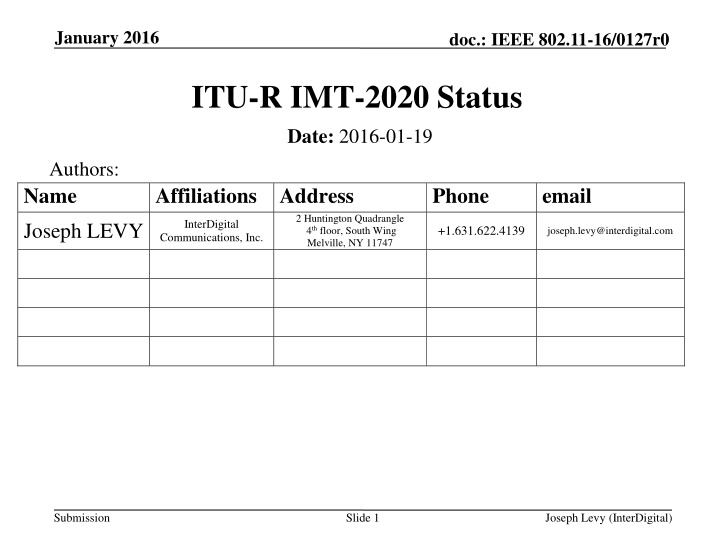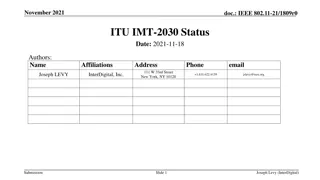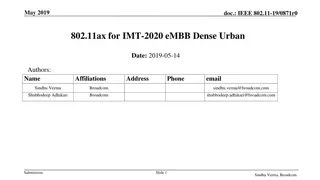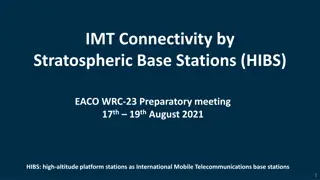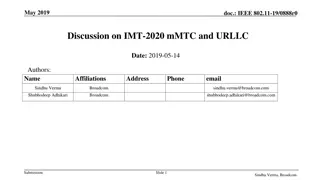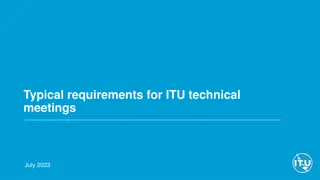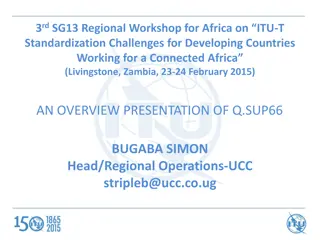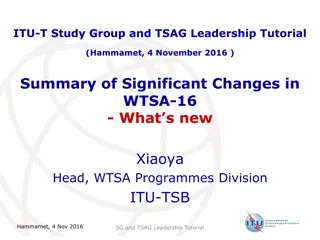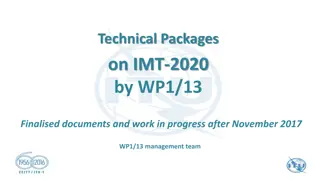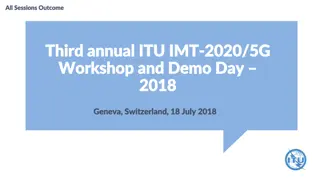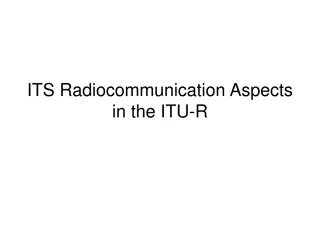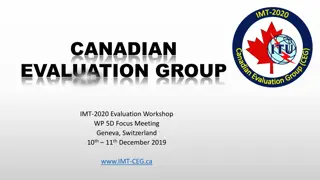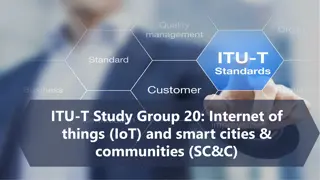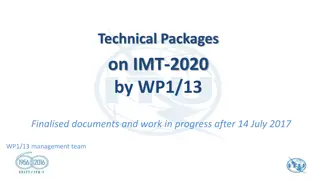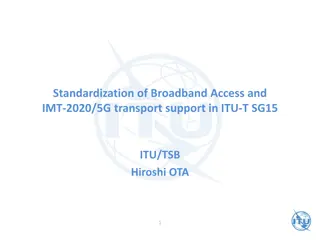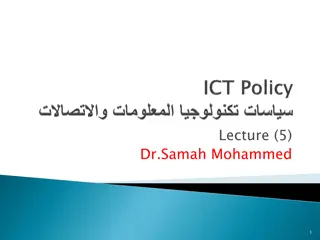Overview of ITU IMT-2020 Activity
This contribution delves into the ongoing ITU IMT-2020 activity, providing a detailed summary of the current ITU-R documents. It covers the background of IMT-2000, IMT-Advanced, the vision of IMT-2020, and the technology involved. The role of ITU in coordinating global radio spectrum usage and setting technical standards is elucidated, along with discussions on IMT-2000 and IMT-Advanced technologies.
Download Presentation

Please find below an Image/Link to download the presentation.
The content on the website is provided AS IS for your information and personal use only. It may not be sold, licensed, or shared on other websites without obtaining consent from the author.If you encounter any issues during the download, it is possible that the publisher has removed the file from their server.
You are allowed to download the files provided on this website for personal or commercial use, subject to the condition that they are used lawfully. All files are the property of their respective owners.
The content on the website is provided AS IS for your information and personal use only. It may not be sold, licensed, or shared on other websites without obtaining consent from the author.
E N D
Presentation Transcript
January 2016 doc.: IEEE 802.11-16/0127r0 ITU-R IMT-2020 Status Date: 2016-01-19 Authors: Name Affiliations Address Phone email 2 Huntington Quadrangle 4th floor, South Wing Melville, NY 11747 InterDigital Communications, Inc. Joseph LEVY +1.631.622.4139 joseph.levy@interdigital.com Submission Slide 1 Joseph Levy (InterDigital)
January 2016 doc.: IEEE 802.11-16/0127r0 Abstract This contribution discusses the ongoing ITU IMT-2020 activity and provides an overview summary of the currently available ITU-R documents. Submission Slide 2 Joseph Levy (InterDigital)
January 2016 doc.: IEEE 802.11-16/0127r0 Agenda Description of ITU and ITU-R IMT-2020 Background: IMT-2000, IMT-Advanced IMT-2020 Vision IMT-2020 Technology Bottom Line Submission Slide 3 Joseph Levy (InterDigital)
January 2016 doc.: IEEE 802.11-16/0127r0 ITU The ITU International Telecommunications Union Is a specialized agency of the UN and is responsible for issues that concern information and communications technology The ITU coordinates the shared global use of the radio spectrum Assists in the development of worldwide technical standards Technologies include: broadband internet, latest-generation wireless technology, internet access, data, voice, TV broadcasting, next-Generation networks, ITU-R - the Radiocommunications Sector of ITU The role of the ITU-R is to ensure the rational, equitable, efficient and economical use of the radio-frequency spectrum by all radiocommunication services The regulatory and policy functions of the ITU-R are performed by World and Regional Radiocommunication Conferences and Radiocommunication Assemblies supported by Study Groups. Submission Slide 4 Joseph Levy (InterDigital)
January 2016 doc.: IEEE 802.11-16/0127r0 IMT-2000, IMT-Advanced IMT International Mobile Telecommunications IMT-2000 technologies (Marketed as 3G): 3GPP Family: UMTS UTRA-FDD/W-CDMA UTRA-TDD LCR/TD-SCDMA UTRA-TDD HCR/TD-CDMA 3GPP2 Family: CDMA2000 (1xEV-DO Rev A, EV-DO Rev B) IMT-Advanced technologies (Marketed as 4G): 3GPP Family: LTE Advanced (E-UTRA) IEEE Family: WiMAX (802.16m) ITU as basically defined IMT as Cellular Telephone Submission Slide 5 Joseph Levy (InterDigital)
January 2016 doc.: IEEE 802.11-16/0127r0 IMT-2020 IMT-2020 is an ITU-R project to define the framework and overall objectives of the future development of IMT to better serve the needs of the networked society, for both developed and developing countries Key IMT-2020 Documents: IMT Vision Framework and overall objectives of the future development of IMT for 2020 and beyond [1] Future technology trends of terrestrial IMT systems [2] Submission Slide 6 Joseph Levy (InterDigital)
January 2016 IMT Vision Framework and overall objectives of the future development of IMT for 2020 and beyond [1] doc.: IEEE 802.11-16/0127r0 In this Recommendation, the framework of the future development of IMT for 2020 and beyond, including a broad variety of capabilities associated with envisaged usage scenarios, is described in detail. Furthermore, this Recommendation addresses the objectives of the future development of IMT for 2020 and beyond, which includes further enhancement of existing IMT and the development of IMT-2020. It should be noted that this Recommendation is defined considering the development of IMT to date based on Recommendation ITU-R M.1645. Submission Slide 7 Joseph Levy (InterDigital)
January 2016 doc.: IEEE 802.11-16/0127r0 IMT 2020 Usage Scenarios [1] Enhanced Mobile Broadband: Wide-Area Coverage Seamless coverage Medium to high mobility Improved user data rate (compared to IMT-Advanced, but lower than Hotspot) Hotspot High user density Very high traffic capacity Low mobility High data rate Submission Slide 8 Joseph Levy (InterDigital)
January 2016 doc.: IEEE 802.11-16/0127r0 IMT 2020 Usage Scenarios [1] (cont.) Ultra-reliable and low latency communications: Wireless control of industrial manufacturing/production processes Remote medical surgery Distribution automation in a smart grid Transportation safety And others Massive machine type communications: Very large number of connected devices Low volume, non-delay sensitive data Low cost, long batter life Submission Slide 9 Joseph Levy (InterDigital)
January 2016 doc.: IEEE 802.11-16/0127r0 The current IMT view of RLAN [1] 2.1.4 Maintaining high quality at high mobility Maintaining high quality at high mobility will enable successful deployment of applications on user equipment located within a moving platform such as cars or high-speed trains which are being deployed in several countries. Connectivity on mobile platforms may be provided via IMT, Radio Local Area Network (RLAN) or another network on that platform using suitable backhaul. Submission Slide 10 Joseph Levy (InterDigital)
January 2016 doc.: IEEE 802.11-16/0127r0 The current IMT view of RLAN [1] 2.3.3 Technologies to enhance mobile broadband scenarios IMT systems currently provide support for RLAN interworking, at the core network level, including seamless as well as non-seamless mobility, and can offload traffic from cellular networks into license-exempt spectrum bands. 6.1.2 Relationship between IMT-2020 and other access systems IMT-2020 will interwork with other radio systems, such as RLANs, broadband wireless access, broadcast networks, and their possible future enhancements. IMT systems will also closely interwork with other radio systems for users to be optimally and cost-effectively connected. Submission Slide 11 Joseph Levy (InterDigital)
January 2016 doc.: IEEE 802.11-16/0127r0 The current IMT view of RLAN [2] 5.3.7 RLAN Interworking Radio local area networks (RLANs) based on the 802.11 family of standards are already used by many operators for offloading cellular networks and embracing capacity expansion into license-exempt spectrum bands. The LTE specifications provide support for RLAN interworking, including seamless as well as non- seamless mobility, at the core network level. The selection whether to use RLAN or 3GPP access currently resides in the terminal and is implementation-specific. Existing terminals have no information about the network load and typically connect to the RLAN whenever such a network is found, irrespective of which technology would be preferable from an end-user perspective in a particular scenario. Hence, existing terminals may switch to an RLAN even if it is heavily loaded and the LTE connection would provide significantly better end-user experience. Providing the system with mechanisms to support control by the network over the radio-access technology used by the terminal can remedy this situation. Submission Slide 12 Joseph Levy (InterDigital)
January 2016 doc.: IEEE 802.11-16/0127r0 The current IMT view of RLAN [2] 5.6.2.4 Multi-radio access and multi-mode The trend to integrate multiple radio access technologies seamlessly will accelerate due to the need to integrate new spectrum bands, licensed and unlicensed to meet capacity demands, and to support usages such as IoT wherein IoT devices with non-cellular radio may connect to cellular network through a multi-radio gateway. The coexistence of multi-RAT (e.g. pre-IMT/IMT/RLAN) introduces many challenges for operators, e.g. burdened maintenance and difficult operation with multiple management system, degraded user experience such as delay and power consumption due to interoperability between different RATs/modes, imbalanced and low resources utilization of different RATs, inflexible and inefficient traffic steering since the RRM entity is independent from each other, and so on. Submission Slide 13 Joseph Levy (InterDigital)
January 2016 doc.: IEEE 802.11-16/0127r0 Opinion regarding the: Current ITU-R View of IMT-2020 IMT-2020 is a next step of IMT-Advanced and IMT-2000 Therefore IMT is focused on the next step for cellular and is not really concerned with non-cellular RATs. IMT-2020 use cases overlap with 802.11 uses, e.g.: Hot Spot: High user density, Very high traffic capacity, Low mobility, High data rate Massive machine type communications (IOT): Very large number of connected devices, Low volume, non-delay sensitive data, Low cost, long batter life IMT-2020 is currently assuming that proposals should be RANs, not RATs 802.11 is a RAT. Submission Slide 14 Joseph Levy (InterDigital)
January 2016 doc.: IEEE 802.11-16/0127r0 IMT-2020 Bottom Line ITU-R via IMT-2020 is defining the 5G network The 5G network will provide wireless technology solutions for many traditional 802.11 use cases IMT-2020 will also provide input to WRC 19 and hence will help drive spectrum allocation decisions, especially in the 5150-5925 MHz and >6 GHz ranges If 802.11 wants to be an IMT-2020 technology it must advocate for itself in ITU-R If 802.11 does not advocate for itself no one else will. Submission Slide 15 Joseph Levy (InterDigital)
January 2016 doc.: IEEE 802.11-16/0127r0 References 1. Recommendation ITU-R M.2083-0 (09/2015), IMT Vision Framework and overall objectives of the future development of IMT for 2020 and beyond , M Series, Mobile, radiodetermination, amateur and related satellite services 2. Report ITU-R M.2320-0 (11/2014), Future technology trends of terrestrial IMT systems , M Series Mobile, radiodetermination, amateur and related satellite services 3. 11-16/0004r0 Next steps for IEEE 802.11 as an IMT-2020 technology? , Andrew Myles Submission Slide 16 Joseph Levy (InterDigital)
January 2016 doc.: IEEE 802.11-16/0127r0 References (cont.) 4. Recommendation ITU-R M.1036 Frequency arrangements for implementation of the terrestrial component of International Mobile Telecommunications (IMT) in the bands identified for IMT in the Radio Regulations (RR) Recommendation ITU-R M.1224 Vocabulary of Terms for International Mobile Telecommunications (IMT) Recommendation ITU-R M.1457 Detailed specification of the terrestrial radio interfaces of International Mobile Telecommunications-2000 (IMT-2000) Recommendation ITU-R M.1645 Framework and overall objectives of the future development of IMT-2000 and systems beyond IMT-2000 Recommendation ITU-R M.1822 Framework for services supported by IMT Recommendation ITU-R M.2012 Detailed specifications of the terrestrial radio interfaces of International Mobile Telecommunications Advanced (IMT-Advanced). Report ITU-R M.2038 Technology trends Report ITU-R M.2074 Radio aspects for the terrestrial component of IMT-2000 and systems beyond IMT-2000 Report ITU-R M.2243 Assessment of the global mobile broadband deployments and forecasts for International Mobile Telecommunications Report ITU-R M.2334 Passive and active antenna systems for base stations of IMT systems Resolution ITU-R 56-1 Naming for International Mobile Telecommunications. 5. 6. 7. 8. 9. 10. 11. 12. 13. 14. Submission Slide 17 Joseph Levy (InterDigital)
